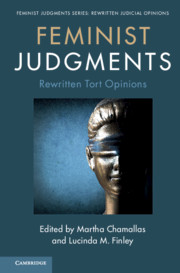Book contents
- feminist judgments: rewritten tort opinions
- Feminist Judgments Series Editors
- Feminist Judgments: Rewritten Tort Opinions
- Copyright page
- Contents
- Notes on Contributors
- Preface
- Table of Cases
- Part I Introduction
- Part II The Classics
- Part III Intentional Torts
- Part IV Negligence and Vicarious Liability
- Part V Damages
- 16 Commentary on G.M.M. v. Kimpson
- 17 Commentary on Simpkins v. Grace Brethren Church of Delaware, Ohio
- Index
16 - Commentary on G.M.M. v. Kimpson
from Part V - Damages
Published online by Cambridge University Press: 28 November 2020
- feminist judgments: rewritten tort opinions
- Feminist Judgments Series Editors
- Feminist Judgments: Rewritten Tort Opinions
- Copyright page
- Contents
- Notes on Contributors
- Preface
- Table of Cases
- Part I Introduction
- Part II The Classics
- Part III Intentional Torts
- Part IV Negligence and Vicarious Liability
- Part V Damages
- 16 Commentary on G.M.M. v. Kimpson
- 17 Commentary on Simpkins v. Grace Brethren Church of Delaware, Ohio
- Index
Summary
In G.M.M. v. Kimpson, noted trial judge Jack Weinstein ruled that using plaintiff’s race or ethnicity to determine the amount of damages in a tort action violates the US Constitution. The case involved a young Hispanic boy who alleged that he suffered cognitive injuries because of exposure to lead paint in his apartment building. The court did not permit the defendant landlord to base its estimate of plaintiff’s likely future earnings on statistics for Hispanic males only, which would have resulted in a lower award than for a comparably injured white child. The rewritten feminist opinion builds on Judge Weinstein’s analysis but extends his reasoning to gender as well as race and ethnicity in order to capture bias against women of color whose injuries are located at the intersection of race, ethnicity, and gender. The feminist opinion describes how the common practice of using race-, ethnic-, and gender-based statistics cannot withstand either strict or intermediate scrutiny and must be replaced by blended tables that include the whole population. The accompanying commentary explains the history behind the use of race and gender-based tables and discusses the complications and tradeoffs of the various methods for remedying the violation.
Keywords
- Type
- Chapter
- Information
- Feminist Judgments: Rewritten Tort Opinions , pp. 361 - 389Publisher: Cambridge University PressPrint publication year: 2020

